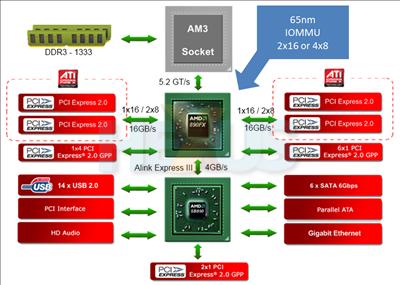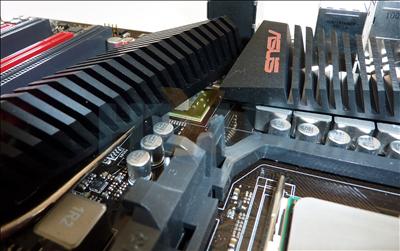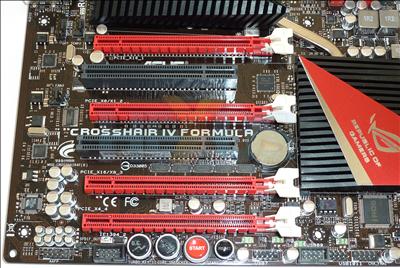890FX: ushering in the Leo platform
Despite offering compatibility with numerous existing AM3 boards, AMD's Thuban parts are launching with a new range of supporting chipsets that themselves usher in a new platform.
Considering that AMD's Dragon platform - consisting of a Phenom II X4 processor, an ATI Radeon HD 4800-series graphics card and AMD 700-series chipset - has remained the chip giant's premium solution for over a year, the successor - dubbed Leo - is well overdue.
Arriving sporadically over the past few months, we've been drip fed the integral components of the Leo platform and it's only now coming together with the introduction of the hexa-core Phenom II X6 processors.
Leo - now AMD's ultimate desktop platform - is put together using a Phenom II X6 CPU, an ATI Radeon HD 5800-series GPU and an AMD 800-series chipset.
The 800-series chipset may sound familiar - and it should, as AMD first introduced the 890GX over a month ago - but it's today being given an official debut with the launch of an entire 800-series line, topped by the enthusiast-orientated 890FX.
As was the case with the previous generation's 790FX and 790GX chipsets, the 890FX and 890GX are differentiated primarily by graphical ability - the latter features an IGP, whilst the former is geared toward high-end discrete GPUs.
The 890FX block diagram, pictured above, shows that the range-topping 800-series chipset has a 65nm northbridge with a generous 32 PCIe lanes available, allowing for boards that support numerous CrossFire configurations - including two cards at x16, x16 or four cards at x8, x8, x8, x8.
The real action lies with the SB850 southbridge, though. Connected to the northbridge via a 2GB/s A-Link Express III interface, it has the bandwidth to facilitate a wide range of current-generation interfaces including six SATA 6Gbps ports, Gigabit Ethernet, and 14 USB 2.0 ports. Superspeed USB 3.0 doesn't feature as standard, but you can expect most manufacturers to offer USB 3.0 ports via a third-party controller.
For an in-depth look at AMD's 890GX chipset, head on over to our full review of the ASUS M4A89GTD PRO/USB3. Only interested in 890FX? Here's a brief tour of a supporting highe-end board from Taiwanese manufacturer ASUS.
A look at the ASUS Crosshair IV Formula
For the purpose of our review, AMD provides one of the ultimate 890FX boards; the ASUS Crosshair IV Formula. Priced at around £165, the high-end board forms part of ASUS's Republic of Gamers line and targets the overclocking crowd with an array of overclocking tools, a sprinkling of over-the-top heatsinks and room for four PCIe 2.0 slots.
The board's AM3 socket - powered by an 8+2 phase power design - supports AMD CPUs with a TDP of up to 140W, whilst dual-channel memory slots support up to 16GB of DDR3 at speeds of up to 1,866MHz.
A SupremeFX X-Fi audio chip is integrated as standard, as are a bevy of ASUS-exclusive tweaking tools - including RoG Connect, GameFirst, Extreme Tweaker and Core Unlocker, which allows users to potentially enable hidden/disabled cores on certain AMD CPUs at the touch of a button.
On top of that you'll find eight fan connectors, seven ProbeIt measurement points and three thermal sensor connectors. Everything a tweaking man needs.
A contender for one of the best-looking AMD boards to date? Perhaps, and ASUS has hit the nail on the head with the AMD Radeon-inspired red-and-black colour scheme.
Six of the seven SATA ports are of the 6Gbps variety, powered by AMD's SB850 southbridge and supporting RAID modes 0, 1, 5 and 10, whilst the standalone seventh SATA port provides 3Gbps connectivity courtesy of a JMicron JMB363 controller.
The southbridge heatsink looks cool, but it's also suitably low profile so as not to hamper the use of any PCIe slot.
Speaking of PCI slots, the Crosshair IV Formula has a useful selection. Three PCIe x16 slots are available, allowing for a single card at x16, dual cards at x16, x16 or a three-way CrossFire configuration at x16, x8, x8. It's an all-AMD affair, though, as there's no support for NVIDIA SLI.
The fourth PCIe 2.0 lane operates at x4, and two PCI 2.2 slots complete the line up. Alongside the board's Start and Reset buttons reside a dedicated Core Unlocker button and a dedicated Turbo Key switch.
Keeping the features coming, the rear I/O panel provides a single 3Gbps eSATA connector (powered by the JMicron JMB363 controller), seven USB 2.0 ports, two USB 3.0 ports (powered by an NEC controller) FireWire, Gigabit Ethernet and a choice of eight-channel audio or optical S/PDIF out. Overclockers are also treated to a ROG Connect on/off switch and a Clear CMOS switch.
For most users, an 890GX offering - ASUS's own ASUS M4A89GTD PRO/USB3, for example - offers many of the features for around £50 less. However, if you're considering a multi-GPU CrossFire configuration or have a history of overclocking the hell out of things, the Crosshair IV Formula looks a solid base.
Now, time for some benchmarks.















